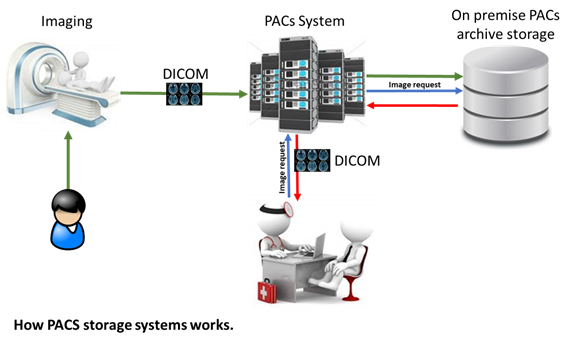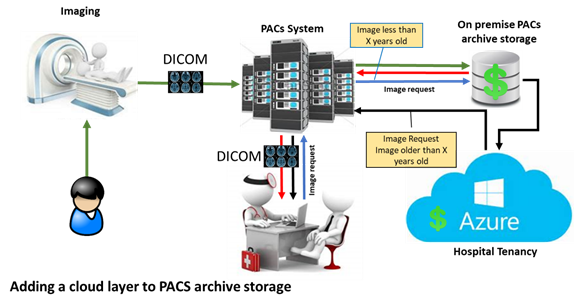How To Excise The Risk Of Storing Healthcare Data In The Cloud
By Bill Tolson, Vice President, Archive360
Doctors, hospitals, and other healthcare organizations are becoming ever-more reliant on diagnostic imaging via X-rays, MRIs, CT scans, tomography, and other formats. With increased usage of these types of images comes increased volume of data known as Digital Imaging in Communications in Medicine (DICOM) files.
The situation is exacerbated since DICOM images, which are a major consumer of storage, are part of patient-related healthcare data, alongside physician and clinician reports and other patient communications. While advances in the quality of diagnostic imaging technologies have come hand in hand with the wider use of digital imaging as a diagnostic tool, there has been a related consequence: larger file sizes and more data that healthcare organizations must secure, store, and make readily accessible to doctors and other healthcare providers.
Cutting Down Cost And Complexity
You can probably see where I’m going in terms of the complications this problem can ultimately cause. As DICOM files multiply within health organizations, providers find themselves left with a ballooning expense and storage footprint for all of their diagnostic images. Many health organizations are thus currently trying to determine the best strategy for cutting down on the cost, complexity, and risk of storing DICOM and other healthcare data. Reducing storage costs has become critical for the industry, especially as these diagnostic procedures become more easily accessible to smaller clinicians’ groups and healthcare systems, since they help improve patient outcomes and verify diagnosis.
In the healthcare industry, it has traditionally been necessary for hospitals to store this large volume of DICOM images in their own on premise storage systems. Hospitals have their own Picture Archiving and Communications System (PACS) that are expressly for this purpose, serving as the main systems behind the storage, management, security, and access of DICOM images.
In Figure 1 below, you can see how the PACS system generally works. When a medical technician generates an image, the technician routes it to the PACS on-premise storage system, where it is then archived. Next, once a doctor is ready to review the diagnostic images in order to make a diagnosis, he or she will request the images through the PACS system. The PACS locates the needed files and sends them to the doctor’s workstation fro review. Another benefit of the PACS system is that it offers physicians multifaceted capabilities via specialized viewers, making the PACS key to storing and retrieving DICOM images.

Cloud Combo
Until recently, PACS on premise storage was the only game in town for these large diagnostic images, as there were few alternatives when it came to cost concerns, regulatory security, and access, and convenience. When the images were within the health organization’s own facility, doctors and medical departments could pull up these files quickly and easily, whether for scheduled patient visits or unexpected emergencies.
But the evolution of the healthcare industry has created challenges that have made on premise storage much more costly. In particular, imaging systems has become more powerful creating much larger images, physicians are ordering more images, and regulatory requirements are causing imaging to be stored for much longer periods of time. As this has happened, the cloud has become the more accessible, secure, and scalable storage solution for many hospitals and health systems, due to the need to keep costs under control while rising security for patient data. Because of these developments, the use the cloud for long-term management and storage of DICOM files has picked up markedly.
Today’s technologies allow for the addition of this second layer to the PACS that provides even more cost-effective—and more efficient—storage and management of DICOM images that are accessed infrequently. The benefits multiply as healthcare organizations save on a combination of reduced physical storage costs and lower regulatory risk. The cloud has made it possible for hospitals to consolidate their plethora of healthcare information—including diagnostic imaging, data, and communications—from across disparate information silos into a single, secure cloud-based archive that’s easy to access.
Boosting Benefits
With such a solution, healthcare organizations now create their own retention/disposition policies, which can automatically identify and then move historical, little-accessed images to the organization’s cloud (for example, their Azure cloud). This type of system can base the storage location on the date that the file was created, the last time the file was accessed, or patient status so that medical personnel can find them whenever they need them without incurring lags in recall or additional costs for hardware, software, or support. In fact, using this type of system has been shown to reduce the costs of on premise storage by as much as 90 percent.
You can see the difference from using the PACS alone in Figure 2 below. As the process flow shows, when an image is more recent—say less than two years old—the request for the image channels through on premise PACS storage. But if the image is older—say two years or older—its storage and management is handled by the hospital’s own cloud tenancy. A doctor can request a specific DICOM file without worrying about how old it is, since the PACS and cloud combo solution knows where to find the stored image. Whether the image is on premise or in the hospital’s cloud storage, it’s easily and securely retrievable, and the needed application capability gets included for the doctor’s review.

As you can see from the variance in the two figures, it makes sense why a growing number of healthcare organizations that are seeking affordable alternative solutions for maintaining and transmitting their huge archive of DICOM files are turning to the cloud. By reducing their reliance on PACS-only on premise storage, hospitals and other health providers gain more accessibility, scalability, and security for their files when they additionally incorporate cloud-based solutions that help support the long-term storage of DICOM files.
In addition to reducing an organization’s expenses for physical storage and ensuring regulatory compliance, this route also gives companies more control over their management and archiving capability. It allows IT administrators to set their own policies on image movement and retention/disposition, as well as set encryption capabilities, assign security protocols such as access controls, and use system wide auditing to produce detailed reports. In short, a PACS–cloud combo offers a way to simplify workflows by consolidating diagnostic imaging, data, and communications from across disparate PACS silos into a single, compliant archive in the cloud—without raising the overall costs of healthcare administration or affecting patient care.
About The Author
Bill Tolson is vice president of Archive360 (https://www.archive360.com
